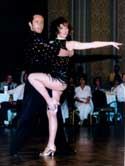Talking to Melanie Roberts, owner of Gotta Dance L.A. is like dancing the upbeat, youthful moves of Swing. She's animated and easygoing, which isn't surprising, considering she's spent most of her life jivin' her way through competitions and performances. She's the 1993-1994 U.S. Open Swing Champion, and she's been a member of the California Swing Dance Hall of Fame since the early 1990s. Her energy quickly becomes apparent when she talks about her passion for the state dance of California. "West Coast Swing is about tuning into the music," she says. "The dance is distinguished by its love affair with syncopations and musical interpretation. A dancer reflects what he is hearing in the music with his body and two beats later his partner can respond to the move. Both partners can chuckle to music."
As a teacher, Roberts works hard to help her students understand this relationship, and she emphasizes that "good communication skills are key" to successful teaching. This is part of the reason why she pursued a Masters degree in Psychology. "The mind and emotions are part of our bodies and how we relate to our partners," she says. "Knowledge of human behavior is helpful in teaching." Roberts' teaching partner, Archie Dawson (who is a Hustle champion himself) points out that aspiring dancers flock to Gotta Dance L.A. classes because "Melanie genuinely cares about her students."
"My students have shown me a lot of respect," says Roberts, "therefore it is my responsibility to help and give them the best that I can with fun and humor. Dance like life is a learning process. It's important to enjoy the process." The enthusiastic chatter of students exiting her class is evidence that Roberts does, indeed, promote a relaxed learning environment.
Her teaching style doesn't preclude demanding excellence from her students however. Roberts is strict about adhering to the foundation and principles of swing style. "West Coast Swing is energized by an elasticity which is created at the end of the slot by an anchor step," she says. "Mastery of compression and leverage is crucial, and certainly mastery of the rhythm is important."
The basic rhythm is a double - one step per beat of music - followed by two triple steps. "Unlike East Coast (Swing) where there is a rock-back on one/two, the lady steps forward into the slot on counts one and two. And there is a pulsing movement - a slight toning of the body - on the even numbers," explains Roberts. By burning the West Coast rhythm into their muscle memory, dancers can freely syncopate the steps and express the nuances of a song. Roberts prefers that her students keep styling at a minimum until technique is tuned to perfection.
"The objective of dance is to use our bodies (our instruments) to express the music while working with our partners," she explains. "We don't want to do syncopations until we've learned how to use our instruments properly. Like a musician, a beginner can't play a Mozart with mastery until he's learned how to use his instrument properly."
Her dedication to the art of dance can be partly attributed to English mother who, finding herself on a California cattle ranch, decided to introduce dance classes to her community. As a young adult, Roberts enrolled in East Coast Swing classes on a whim. She says that her instructors, Jonathan Bixby and Sylvia Sykes, "gave me a taste of swing in the '40s." The upbeat teaching style of Bixby and Sykes made a great impression on the young Roberts, so much so that she later adopted it for her own studio. She was also influenced by swing icons Frankie Manning and Steve Mitchell, who were regular guest instructors for Bixby and Sykes.
The first professional swing performance that Roberts attended was a shock. "When I first saw West Coast Swing at the U.S. Opens, I was horrified," she says. "Most of the women were dressed in micro-minis with fish nets and G-strings!" Why did she continue swinging? "I enjoyed watching exceptional dancers like Michelle Kinkaid, Mary Ann Nunez and Charlotte Jansen-Bott who really related to and expressed the music through their bodies," she says. "West Coast Swing continues to be a favorite dance for me because ensconced in the dance is musical interpretation and expression."
Kinkaid, Nunez and Jansen-Bott are renowned champions in West Coast Swing. Roberts says that she never dreamt she would win the coveted title away from these women. "I just wanted to be the best I could be. I was blown away when Robert Cordoba asked me to be his dance partner!"
As a studio owner, Roberts' focus is now firmly set on teaching the best classes she possibly can in West and East Coast swing and Hustle. "Contributing to people - my students - in a positive way is a top priority for me," she says. As for any possibility of returning to dance, she first dismisses the idea but, after some thought, confesses, "Yes, I'd compete again. But I'd make it more of a learning process. I'd compete with an intention to really enjoy the dance!"
### |
.
